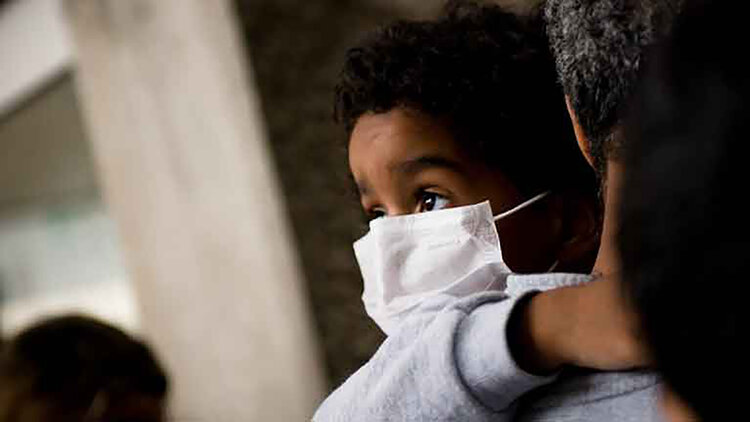
Since the omicron variant is more transmissible and is the dominant one in the country, health experts recommend that adults and children replace cloth or surgical masks with higher quality masks, such as KN95 or KF94.
California children are required to wear facemasks at all times while at school, but the state does not require a specific type.
Some school districts such as Oakland Unified, Berkeley Unified and West Contra Costa Unified have ordered KN95 masks for children since their return from winter break, and after students, parents and teachers demanded them.
However, many Californian parents who want their children to wear the most protective masks have been left to their own devices due to the national shortage of children's versions.
The state Office of Emergency Services is distributing a total of 6 million child-size N95 mouthpieces to county offices of education, which will be distributed to schools.
For students who do not have access to KN95 or KF94 masks, California public health officials advise using a surgical or surgical mask with a fabric mask on top. Students wearing fabric masks are advised to opt for masks with three or more layers of fabric. Any mask that a student wears comfortably is better than none at all, according to public health officials.
What constitutes a high-quality mask, and why are they better at preventing COVID than cloth or surgical masks?
The California Department of Public Health considers KN95, N95 and KF94 masks to be the best masks for preventing COVID because they are made of synthetic fibers that filter out at least 95 percent of airborne particles (94 percent in the case of KF94) when worn correctly.
Although N95s offer the highest level of protection, according to the U.S. Centers for Disease Control and Prevention (CDC), they are not intended for use by children, so the National Institute for Occupational Safety and Health (NIOSH) has not approved them for children. (CDC), they are not intended for use by children, so the National Institute for Occupational Safety and Health (NIOSH) has not approved them for children.
Experts say cloth and surgical masks are not as effective at filtering out smaller air particles, which means it is easier to inhale aerosol droplets containing the virus.
KN95s are manufactured in China to Chinese standards, and KF94s are manufactured in South Korea to South Korean standards.
What if my child does not want to wear a KN95 or KF94 mask?
Although respirators have better filtration than others, their effectiveness depends on their proper and consistent use, according to the CDC.
If the mask is uncomfortable for the child, it causes them to remove it frequently or wear it incorrectly, and a respirator-type mask is not as beneficial. For this reason, Rick Malley, M.D., professor of pediatrics at Harvard Medical School, says surgical masks may be a more realistic option for children.
Facemasks usually have a fitting guide on the packaging, but in general, they should completely cover the nose and mouth, fit snugly to the sides of the face, and have no gaps. According to CDC, they should only be fastened by ear loops, cords, or head straps, and not by the surface of the mask.
Dr. Sten Vermund, dean of the Yale School of Public Health, told New York Magazine that parents should make facemask use "fun and games."
Can masks be reused?
Outside of healthcare settings, experts say it is safe to use KN95 and KF94 masks more than once, although the number of times they can be reused depends on their condition and proper storage.
The virus that causes Covid-19 has an expected survival time of 72 hours, so wait at least that long before reusing the mask, according to CDC recommendations for healthcare workers. The CDC recommends storing the masks in a "breathable paper bag" between uses, and other experts say keeping those paper bags in a dry, sunny place can help inactivate the virus.
Experts say there is no hard and fast rule about how many times a mask can be reused, although it does degrade somewhat with each use due to moisture caused by breathing. If it becomes damaged or the elastic band stretches so that it no longer fits well, if the material looks dirty, or if it is difficult to breathe through, it is time to throw it away. If they get wet, they degrade, which is why you shouldn't try to wash them, experts say.
They advise to throw it away even after a single use if it has been used in close contact with someone who has given COVID.
How can I identify a genuine KN95 or KF94 mask?
The growing demand for KN95 and KF94 masks has led to the sale of low-quality knockoffs, especially on Amazon. The CDC estimated that 60 percent of KN95 masks sold in the United States in 2020 and 2021 were counterfeit.
Since KN95 and KF94 masks are not certified in the United States, any such mask claiming to be certified by the National Institute for Occupational Safety and Health, or NIOSH, is probably fake. And since NIOSH has not approved N95s for children, any that claim to be child-size N95s are also probably fake. The CDC maintains a list of counterfeit respirator products here.
The N95 Project, a non-profit personal protective equipment clearinghouse, tests its masks as do U.S. distributors Bona Fide Masks and Wellbefore.
Can I use a mask with an expired expiration date?
As stocks of masks are depleted, some families may receive masks that are older than the expiration date indicated on the packaging.
NIOSH has determined that facemasks can remain effective after their expiration date, but only if they are properly stored in a cool, dark place. While mask filters typically maintain their functionality after their expiration date, ear loops or headbands may degrade in sunlight, according to Bona Fide Masks.
You may be interested in: Children from 12 to 17 years old are allowed to be vaccinated without parental consent


